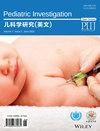Dwell time and bloodstream infection incidence of umbilical venous catheterization in China
IF 2
4区 医学
Q2 PEDIATRICS
引用次数: 0
Abstract
ABSTRACT Importance Central line‐associated bloodstream infection (CLABSI) is one of the most serious complications of central venous access devices. Reducing the risk of CLABSI is of utmost significance in efforts to improve neonatal mortality rates and enhance long‐term prognosis. Objective To determine the dwell time and incidence of CLABSI of umbilical venous catheterization (UVC) for preterm infants in China. Methods Preterm infants with UVC admitted to 44 tertiary neonatal intensive care units in 24 provinces in China were enrolled. Study period was from November 2019 to August 2021. The end point of observations was 48 h after umbilical venous (UV) catheter removal. The primary outcomes were dwell time of UV catheter and UVC‐associated CLABSI. Data between infants with UV catheter dwell time ≤7 days and >7 days, and with birth weight (BW) ≤1000 g and >1000 g were compared. Results In total, 2172 neonates were enrolled (gestational age 30.0 ± 2.4 weeks, BW 1258.5 ± 392.8 g). The median UV catheter dwell time was 7 (6–10) days. The incidence of UVC‐associated CLABSI was 3.03/1000 UV catheter days. For infants with UV catheter dwell time ≤7 days and >7 days, the UVC‐associated CLABSI incidence was 3.71 and 2.65 per 1000 UV catheter days, respectively, P = 0.23. For infants with UVC dwell times of 3–6, 7–12, and 13–15 days, the UVC‐associated CLABSI rates were 0.14%, 0.68%, and 2.48% ( P < 0.01). The Kaplan–Meier plot of UV catheter dwell time to CLABSI showed no difference between infants with BW ≤1000 g and >1000 g ( P = 0.60). Interpretation The median dwell time of UV catheter was 7 days, and the incidence of UVC‐associated CLABSI was 3.03/1000 catheter days in China. The daily risk of UVC‐associated CLABSI and other complications increased with the dwell time.中国脐静脉置管停留时间与血流感染发生率
中心静脉相关血流感染(CLABSI)是中心静脉通路装置最严重的并发症之一。降低CLABSI的风险对于提高新生儿死亡率和提高长期预后具有重要意义。目的了解中国早产儿脐静脉置管(UVC)中CLABSI的停留时间和发生率。方法选取全国24个省44个新生儿三级重症监护病房收治的UVC早产儿。研究时间为2019年11月至2021年8月。观察终点为脐静脉(UV)导管拔除后48小时。主要结果为UV导管的停留时间和UVC相关的CLABSI。比较UV导管停留时间≤7天和≤7天、出生体重(BW)≤1000天和≤1000天婴儿的数据。结果共纳入新生儿2172例(胎龄30.0±2.4周,体重1258.5±392.8 g),中位UV导管停留时间为7 (6-10)d。UVC相关CLABSI的发生率为3.03/1000 UV导管日。对于UV导管停留时间≤7天和≤7天的婴儿,UVC相关的CLABSI发生率分别为3.71和2.65 / 1000 UV导管天,P = 0.23。对于UVC滞留时间为3 - 6,7 - 12,13 - 15天的婴儿,UVC相关的CLABSI率分别为0.14%,0.68%和2.48% (P <0.01)。在Kaplan-Meier图中,BW≤1000 g和>1000 g婴儿的UV导管停留时间对CLABSI没有差异(P = 0.60)。在中国,UV导管的中位停留时间为7天,UVC相关CLABSI的发生率为3.03/1000导管天。UVC相关CLABSI和其他并发症的每日风险随着滞留时间的增加而增加。
本文章由计算机程序翻译,如有差异,请以英文原文为准。
求助全文
约1分钟内获得全文
求助全文
来源期刊

Pediatric Investigation
Medicine-Pediatrics, Perinatology and Child Health
CiteScore
3.30
自引率
0.00%
发文量
176
审稿时长
12 weeks
 求助内容:
求助内容: 应助结果提醒方式:
应助结果提醒方式:


